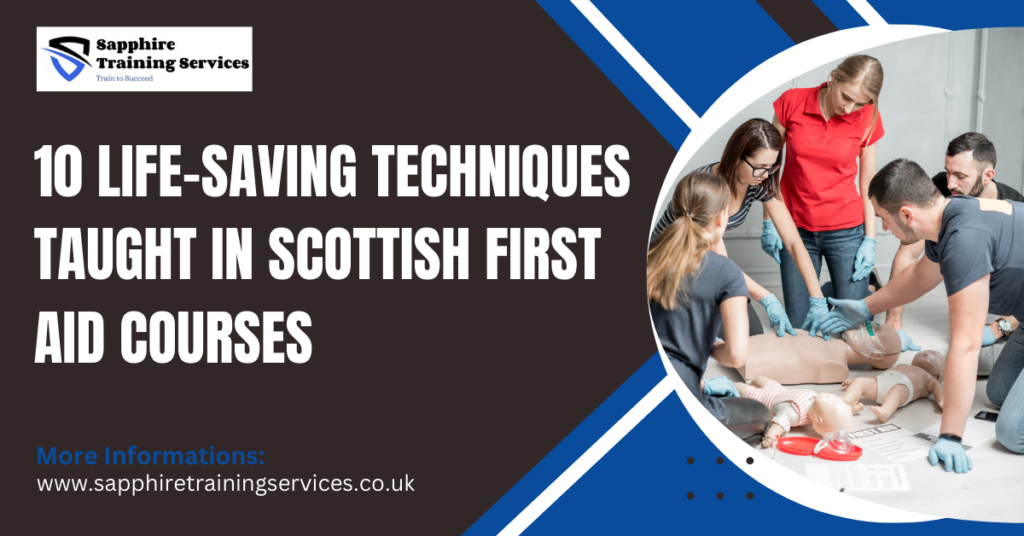When emergencies strike, having first aid knowledge can mean the difference between life and death. Whether it’s a minor injury or a life-threatening situation, being trained in first aid gives you the confidence to act quickly and effectively. Scottish first aid courses teach essential life-saving techniques that prepare you for real-world emergencies.
In this blog post, we will explore 10 key techniques you will learn in First Aid Training Scotland. These skills can help save lives at home, in the workplace, or in public places.
1. CPR (Cardiopulmonary Resuscitation)
CPR is one of the most critical first aid techniques. It helps maintain blood circulation and oxygen supply to the brain when someone’s heart stops beating.
How to Perform CPR:
- Check if the person is unresponsive and not breathing normally.
- Call emergency services immediately.
- Start chest compressions by pushing hard and fast in the center of the chest at a rate of 100-120 compressions per minute.
- If trained, provide rescue breaths after every 30 compressions.
Real-Life Example: A Scottish office worker performed CPR on a colleague who collapsed at work, keeping him alive until paramedics arrived.
2. Using an AED (Automated External Defibrillator)
AEDs are life-saving devices used during cardiac arrests. They deliver an electric shock to restart the heart.
How to Use an AED:
- Turn on the device and follow the voice instructions.
- Attach the electrode pads to the patient’s chest.
- The AED will analyze the heart rhythm and advise if a shock is needed.
- Stand clear and deliver the shock when prompted.
Many public places in Scotland now have AEDs, making it easier to help in an emergency.
3. Treating Severe Bleeding
Heavy bleeding can be life-threatening if not controlled quickly. Knowing how to stop bleeding is essential.
Steps to Stop Bleeding:
- Apply direct pressure to the wound with a clean cloth or bandage.
- Elevate the injured limb if possible.
- If bleeding doesn’t stop, apply a tourniquet above the wound (only if necessary).
- Seek medical help immediately.
4. Choking Relief
Choking can occur suddenly, especially in children and older adults. Quick action can prevent a fatal outcome.
How to Help a Choking Person:
- Encourage them to cough if they can.
- If coughing doesn’t work, stand behind them and give five firm back blows.
- If that fails, perform the Heimlich maneuver by delivering abdominal thrusts.
- If they become unconscious, start CPR.
Scottish restaurants and childcare centers often require staff to be trained in this technique.
5. Dealing with Burns and Scalds
Burn injuries are common and can happen in workplaces, kitchens, and industrial sites.
First Aid for Burns:
- Cool the burn under running water for at least 10 minutes.
- Remove any clothing or jewelry near the burn but do not remove anything stuck to the skin.
- Cover the burn with a sterile dressing.
- Seek medical help for severe burns.
6. Recognizing and Responding to Strokes
A stroke happens when blood flow to the brain is disrupted. Acting quickly can minimize damage.
Use the FAST Method:
- Face: Is one side drooping?
- Arms: Can they lift both arms?
- Speech: Is their speech slurred?
- Time: Call emergency services immediately if symptoms appear.
Many people who receive quick treatment recover better and faster.
7. Managing Heart Attacks
A heart attack is different from cardiac arrest. The heart continues to beat, but blood flow is blocked.
First Aid for a Heart Attack:
- Call emergency services immediately.
- Keep the person calm and seated.
- Give them aspirin if they are not allergic.
- Monitor their condition and be ready to perform CPR if needed.
8. Handling Fractures and Sprains
Broken bones and sprains require careful handling to prevent further injury.
First Aid Steps:
- Immobilize the injured area.
- Apply a splint or bandage if needed.
- Use an ice pack to reduce swelling.
- Seek medical attention.
9. Treating Shock
Shock occurs when the body doesn’t get enough blood flow, often after severe injury or trauma.
How to Help Someone in Shock:
- Lay them down and elevate their legs slightly.
- Keep them warm and comfortable.
- Reassure them and monitor breathing.
- Call emergency services.
10. First Aid for Seizures
Seizures can be caused by epilepsy, head injuries, or other medical conditions.
What to Do During a Seizure:
- Stay calm and keep the person safe from injury.
- Do not restrain them or put anything in their mouth.
- Place them in the recovery position after the seizure stops.
- Seek medical help if it lasts longer than five minutes.
Why First Aid Training Scotland is Essential
Taking a first aid course in Scotland equips you with these life-saving skills. Whether at work, home, or in public, you’ll know how to react confidently in emergencies. First aid training is also a valuable skill for employment, as many jobs require it.
Key Benefits of Learning First Aid:
- You can save lives.
- It builds confidence in emergencies.
- You become a valuable asset in any setting.
- It improves safety at home, work, and public spaces.
Final Thoughts
Learning first aid is a simple yet powerful way to make a difference. You never know when an emergency might happen, but with the right training, you can be prepared to act quickly. If you haven’t yet, consider enrolling in a First Aid Training Scotland course today and be ready to save a life.

